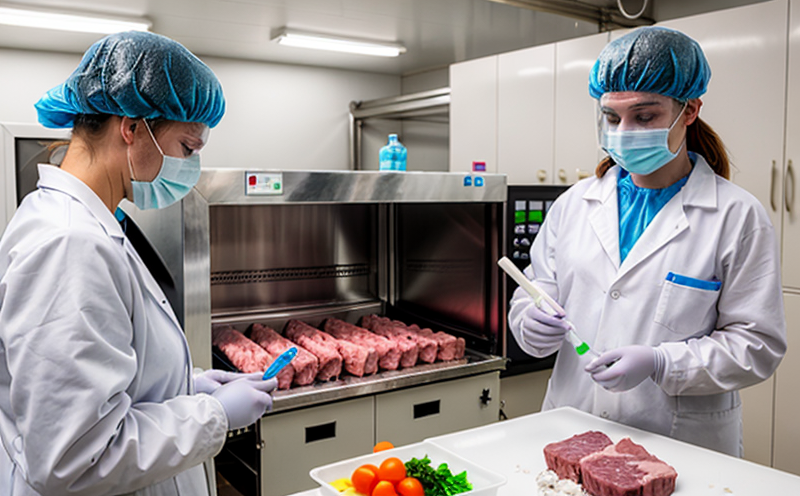OECD Validation of Dairy and Meat Microbiological Methods
The Organization for Economic Co-operation and Development (OECD) validation process provides a rigorous framework to ensure the accuracy, reliability, and reproducibility of microbiological methods used in the dairy and meat industries. This service is critical for quality managers, compliance officers, R&D engineers, and procurement teams looking to enhance product safety, traceability, and regulatory compliance.
The OECD validation process involves a series of standardized tests designed to evaluate method performance against predefined criteria. These tests include assessing the method’s precision, accuracy, repeatability, and robustness under various conditions. The primary goal is to ensure that these methods can consistently produce reliable results across different laboratories and environments.
In the context of dairy microbiology, validation focuses on ensuring that methods accurately detect pathogens such as Listeria monocytogenes, Salmonella enterica, and E. coli O157:H7. For meat microbiology, the focus is on identifying harmful bacteria like Campylobacter jejuni, Pseudomonas aeruginosa, and Salmonella spp.. The OECD validation process ensures that these methods are robust enough to handle the diverse microbial profiles found in dairy and meat products.
The OECD guidelines provide a structured approach to method development, ensuring that all steps from sample preparation to final reporting meet international standards. This includes the use of appropriate culture media, incubation times, and detection techniques. The process also involves the use of reference strains and challenge studies to simulate real-world conditions.
By adhering to OECD guidelines, laboratories can ensure that their methods are validated under controlled conditions, which enhances confidence in method performance. This is particularly important for industries where product safety and regulatory compliance are paramount. For dairy producers and meat processors, this validation process ensures that they meet the stringent requirements set by regulatory bodies such as the Food and Drug Administration (FDA) and the European Union’s Commission Regulation.
The OECD validation process also plays a crucial role in facilitating international trade. Laboratories that have validated their methods according to OECD guidelines are recognized worldwide, ensuring consistency across borders. This is particularly important for exporting countries where local authorities may require proof of method validation before accepting test results.
In summary, the OECD validation process provides a robust framework for ensuring the reliability and accuracy of microbiological methods in dairy and meat industries. By adhering to these guidelines, laboratories can enhance product safety, improve traceability, and ensure compliance with international standards.
Benefits
- Enhanced Product Safety: Validated methods ensure that harmful microorganisms are accurately detected, reducing the risk of contamination in dairy and meat products.
- Increased Regulatory Compliance: Laboratories can demonstrate adherence to international standards, ensuring compliance with regulatory requirements.
- Improved Traceability: Standardized methods allow for consistent results across different laboratories, enhancing product traceability and quality control.
- Facilitated International Trade: Validated methods are widely recognized globally, simplifying the export process and ensuring acceptance by international authorities.
- Increased Customer Confidence: Reliable test results build trust with customers, leading to increased market confidence and customer satisfaction.
The OECD validation process is essential for maintaining high standards in dairy and meat microbiology. By adhering to these guidelines, laboratories can ensure that their methods are robust, accurate, and reliable, meeting the needs of quality managers, compliance officers, R&D engineers, and procurement teams alike.
Customer Impact and Satisfaction
- Increased Trust: By validating methods according to OECD guidelines, laboratories demonstrate a commitment to quality and accuracy, fostering trust among customers.
- Improved Decision-Making: Reliable test results provide critical information for decision-makers in the dairy and meat industries, enabling better-informed choices.
- Enhanced Reputation: Laboratories that adhere to OECD guidelines can build a strong reputation for reliability and accuracy, which is essential in competitive markets.
- Prompter Action: Accurate test results allow for quicker identification and resolution of issues, minimizing the risk of contamination and ensuring product quality.
The impact of OECD validation extends beyond the laboratory to the entire supply chain. By ensuring that methods are reliable and accurate, laboratories play a crucial role in maintaining high standards of food safety and quality. This not only benefits customers but also contributes to the overall reputation of the industry.
International Acceptance and Recognition
The OECD validation process is widely recognized and accepted across international borders, making it a crucial tool for laboratories involved in dairy and meat microbiology. Laboratories that have validated their methods according to these guidelines are able to demonstrate compliance with global standards, which is essential for exporting countries.
By adhering to OECD guidelines, laboratories can ensure that their methods meet the stringent requirements set by regulatory bodies such as the FDA and the European Union’s Commission Regulation. This not only simplifies the export process but also ensures acceptance of test results by international authorities. The recognition of these validated methods globally enhances the reputation of the laboratory and builds trust with customers.
For dairy producers and meat processors, the OECD validation process provides a structured approach to method development, ensuring that all steps from sample preparation to final reporting meet international standards. This is particularly important in an increasingly globalized market where product safety and regulatory compliance are paramount.
The OECD validation process also plays a crucial role in facilitating international trade. Laboratories that have validated their methods according to OECD guidelines are recognized worldwide, simplifying the export process and ensuring acceptance by international authorities. This recognition not only enhances the reputation of the laboratory but also builds trust with customers, leading to increased market confidence and customer satisfaction.





